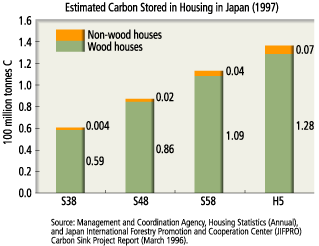|
|
I. Title of the Best Practice
Establishment of Artificial Forests and Carbon Storage in Wood Materials
II. Overview of the Best Practice
A. Features of establishment of artificial forests and carbon storage in wood materials
1. Background
To help prevent global warming, it is important to promote forest management and utilization of local wood materials to ensure that the carbon cycle system functions well, and ultimately a transition is needed to an economy and society with a sound cycle for using forest and wood resources. The linked initiatives of maintaining artificial forests in a way that permits "sustainable use" through proper management, at the same time as contributing to carbon storage by using timber from these artificial forests in wooden structures, could be considered useful practices to prevent global warming.
2. The contents of practice
(1) Establishment of artificial forests
- Regeneration after deforestation
- Promotion of planting on poorly utilized land such as barren land, grasslands and abandoned agricultural land in valleys
- Promoting appropriate forest management
(2) Carbon storage in wood materials
- Promoting wood material utilization: public awareness-raising, promotion of wood utilization in house construction and community improvements, development of new technologies for wood use in order to expand demand for, and lengthen lifetime of, wood products
- Stable supply of goods with high quality and predictable characteristics: enhancement of wood industry and system of production, processing and distribution
- Appealing to related government ministries and local governments to use wood in public works projects (e.g. the Nagano Olympic Memorial Arena, and the large wood structure Odate Jukai Dome.)

B. Reasons for Inclusion as a Best Practice
- It can contribute to the formation of future policies to prevent global warming.
- It can be appropriate for application in, or technical transfers to, developing countries:
- It is suitable to the natural environment and society of the country where it is implemented.
C. Problems and their Solutions
It is important to exploit the carbon storage effects, the carbon emission reduction effects of using timber as an alternative to energy-intensive materials, and the carbon-isolating effects of using timber as an alternative to fossil fuel energy, through the maintenance of healthy forests from the perspective of global warming prevention, effectively exploiting carbon sink and storage functions, and promoting wood use.
For these purposes, this Best Practice promotes proper forest management from the perspective of forest improvement through regeneration of logged areas, tree planting on poorly utilized land, and maximizing the public benefit functions.
The Best Practice also promotes public awareness-raising, wood utilization, and development of new technologies for wood use in order to lengthen the lifetime of wood products, because it is important to expand wood utilization in order to increase carbon storage in wood material. In addition, it enhances the wood industry and system of production, processing and distribution, and promotes the use of wood in public works projects.
III. Categorizing the Best Practice
1. Classification(s)
( X ) Regulatory Approach (Policy approaches-regulations, incentives, etc.)
( X ) Practical Action (Action undertaken independently by a social actor)
( X ) Social Network Mechanism (Cooperative structure)
2. Social Actor(s) Involved
( X ) Citizens
( X ) Central government
( X ) Local government
( X ) Business
3. Sector(s)
( ) Energy ) Energy
( ) Residential ) Residential
( ) Industrial ) Industrial
( ) Transportation ) Transportation
( ) Commerce ) Commerce
( X ) Agriculture/Land Use/ Forestry
( ) Others ( ) Others ( ) )
4. Target Greenhouse Gas(es)
( X ) CO2
( ) CH4 ) CH4
( ) N2O ) N2O
( ) HFC ) HFC
( ) PFC ) PFC
( ) SF6 ) SF6
(  ) Other ( ) Other ( ) )
IV. List of Attachments
Omitted
V. Please indicate a person to contact for more information about this Best Practice.
| Contact Person: |
Shunichi Nakada |
| Title: |
 |
| Organization: |
Office of Environment Policy Coordination, Administration Division, Ministry of Agriculture, Forestry and Fisheries of Japan |
| Email: |
shunichi_nakada1@nm.maff.go.jp |
| Tel: |
+81-3-3502-8111 (ext. 2126) |
| Fax: |
+81-3-3592-7697 |
| Address: |
1-2-1, Kasumigaseki, Chiyoda-ku, Tokyo |
| Note: |
N/A |
|
|
